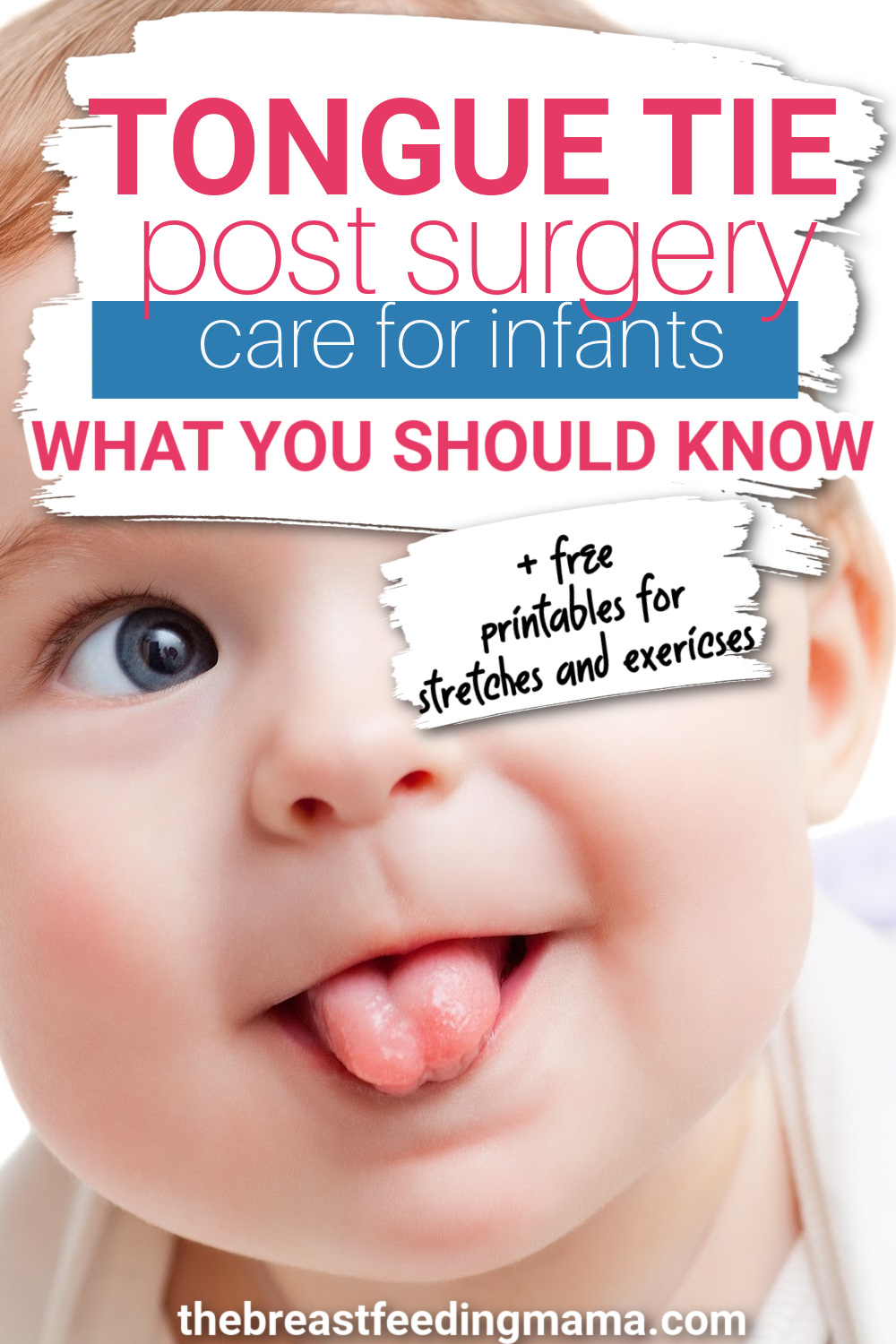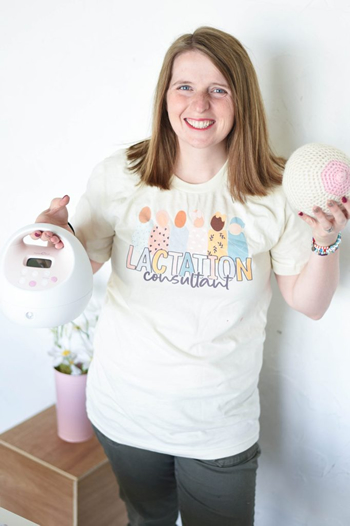Tongue tie and lip tie releases – or frenectomies – are common procedures performed on infants, primarily to assist with breastfeeding success. However, aftercare is essential to proper healing and future success. Here are the best tips for success, along with free printables for suck training and post-release exercises.

Tongue-tie and lip tie releases can be a lifesaver regarding breastfeeding.
Unfortunately, many parents go home after their child has had a frenectomy and wonder why things haven’t improved more.
The answer is often this – they weren’t given the proper instructions for follow-up care.
The truth is, the frenectomy is the first step in the process for more successful breastfeeding. While many new parents DO see immediate relief of the symptoms they or their baby was experiencing, it takes time and a little more work to get your baby to where you want them to be.

How long until I see results from a frenectomy?
As mentioned, some babies have immediate improvement – I experienced this myself with my third baby after his frenectomy. I teared up as I immediately had no more pain.
However, the general rule is that it can take as long as your baby is to see total resolution and improvement. So, the younger your baby is, the quicker you will see results. This is simply because the older your baby is, the more habits they have that are set in place, and it can be harder for them to relearn how to breastfeed.
Tongue Tie Recovery Time
A baby is considered fully recovered from a tongue tie release about 6-8 weeks after the procedure. The provider should examine them at this time to ensure no reattachment has occurred.
Right after the procedure
Babies and infants can suffer from irritability and may cry a lot between 24-48 hours after surgery. Doctors often prescribe pain-relieving medications such as Infant Tylenol (or Ibuprofen if they are over six months). The pain often subsides following the healing of the wound.
Nursing can also be very soothing for a baby, though some may be more resistant to nurses because of the trauma to their mouth. I would recommend doing lots of skin-to-skin and babywearing.
It is not common practice for an infant to have general anesthesia for a tongue tie procedure (and if someone suggests it, I would strongly recommend finding another provider). However, if this does happen to you, be aware that your baby may be extra drowsy.
Regardless, your baby might be sleepy after the procedure, as that is often the baby’s response to pain.
Ideally, you will meet with a lactation consultant immediately following or within 24 hours of having the procedure done to do an exam, asses how baby is eating, and come up with a care plan. If your baby has had trouble with weight gain, this will also need to be closely monitored.
Feeding
You may continue to breastfeed after the procedure. You should ideally be offered a place to nurse immediately following the procedure.
The newfound movements of the tongue may make it difficult for the baby to latch on the breast and can make the baby more irritable as they relearn to nurse. It does take time to overcome the past eating habits.
Getting a deep latch is essential. Try different positions and latching techniques in order to have the greatest success.
If your baby has been getting a bottle and you’d like to try them back at the breast, it is a great time to start reintroducing the breast. Remember, though, that if either of you are feeling frustrated or overwhelmed, it is OKAY to stop and try again later.
Keep your baby close and make sure you and your infant have many skin-skin contacts to enable your baby to search for the breasts and start his natural latching and sucking process. Compress your breasts to ease the milk flow once your baby has latched on. If your baby finds it difficult to suck on the breasts, you can feed him your expressed milk with the help of a syringe or a spoon. If your baby is still facing difficulty, you can contact a lactation consultant.
While you may have already initiated breastfeeding, I strongly recommend taking my class, “Fuss-Free Latching“. This fantastic online course has lots of information on latching, exercises you can do post-release, and much more.
Body Work
One of the BEST things I did after Andrew got his release was visit with a Cranial Sacral Therapist and have her do manual work on Andrew’s mouth. She did gentle techniques to help loosen the tension in his mouth, and it was incredible to see how much more relaxed he was after nursing.
The tongue tie helped with the pain, but the body work we got done just made it seem like he was more comfortable, too.
I would seek out the help of an infant Chiropractor who is familiar with tongue ties or a Cranial Sacral Therapist. You can ask your IBCLC or the office you got the procedure done at for recommendations, as it’s important to go to someone who has experience working with infants after frenectomies.
Exercises after tongue tie release
Your baby needs to perform different movements with the newly freed tongue. The exercises must be carried out between 6-8 times a day and each session must last for a minimum of 15 to 30 seconds.
This may seem like a lot – and it kind of is – but they are essential for helping reattachment and helping your baby’s wounds heal correctly.
Your provider should provide you with specific instructions on this.
However, if they didn’t, here are the exercises – along with videos – from Dr. Ghaheri. He is the leading expert on tongue and ip ties.
A few tips –
- Do the exercises whenever you change your baby’s diaper. This tends to be 6-8 times a day, anyways, and it’s a good way to remind yourself.
- Lay your baby’s head in your lap, with their feet facing away from you.
- Many baby’s do not like these exercises, but they can be done fairly quickly. Do not skip them!
- You may want to swaddle your baby to ensure they don’t swat you away or wiggle too much
- You have to use enough pressure – I made this mistake, and I paid for it when my son’s tongue reattached. I was so worried about hurting him, that I didn’t do them effectively enough.
I cannot emphasize the importance of these. It was really disheartening when I realized a week or so after the initial procedure that the pain had come back – and it was because his tongue had reattached. The dentist we saw told me I really needed to apply more pressure, and once I started doing that, it made the biggest difference, and we had no reattachment.
Suck Training and Massage Techniques
Many babies who have tongue ties often need help with learning to suck more efficiently. An IBCLC or other lactation professional can provide you with suck exercises that you can easily do at home in addition to the stretches and that are specific to your baby’s needs. These are more fun and soothing for a baby than the stretches.
Here are some basic ones you can try:
Always use a clean or gloved finger, tickle above your baby’s lip or directly on their lip. Wait for them to open their mouth and “invite” you before placing a finger in their mouth.
Gum Massage
- When your baby opens their mouth, starting on the bottom gums midline, gently massage with one finger from front to back.
- Repeat on the other side and then on the upper gums.
Tug of War and Pressure
- Insert your finger, nail pointed down, into the baby’s mouth and wait for them to “latch” on and start to suckle
- Once your baby is actively suckling, gentle try to pull your finger out. Don’t do it so harshly that you pull it out but enough that they have the desire to pull it back in. Keep playing tug of war as long as they seem interested.
- If your baby won’t draw your finger in, you can slowly push it in. Make sure you don’t go back to far.
- You can add in a little pressure by gently pressing your finger (nail side down) on the back of their tongue. This adds a bit of weight and helps them learn to better lift their tongue.
- At the end of adding the pressure, flip your finger over so your nail bed is pointed up, and gently pull your finger out to encourage them to bring their tongue down and cup your finger like they would your nipple.
Cheek Massage
- Place one index finger on the inside of the baby’s cheek.
- Use thumb on the outside of the cheek to massage the cheek
Puckering
- Tickle the edges of your baby’s mouth, going back and forth between each corner.
Finger Slide
- Place your finger tip on the tip center of your baby’s tongue
- Gently (with no pressure) slide about half way back on your baby’s tongue.
- Lift up your finger, put it back at the front of your baby’s tongue, and continue
Bottom Lip Tickling
- Gently tickle the center of your baby’s bottom lip
- This will encourage them to stick their tongue out of their mouth and learn to extend their tongue more effectively
Tongue Stroking
- Place your finger tip in the center of your baby’s tongue
- Apply gentle, downward pressure and move forward to the tip of their tongue
- Do this one time, and then lift your finger up and place it back in the center of the tongue and repeat.
- Do not drag your finger back to the center at any point.
Follow Up
You should be instructed to follow-up with the provider who did the release around two weeks post release and six weeks post release. These visits are important to ensure healing is going well and that no reattachment has occured.
With these tongue-tie aftercare tips, your baby’s tongue will heal in no time, and he will eventually learn to bring the newfound movements of the tongue under conscious control. Make sure you continue breastfeeding throughout the entire aftercare procedure to help the baby learn the natural sucking action.
More Posts You May Enjoy:
- 9 Must-Know Tips for Weaning from a Nipple Shield
- Fussy Baby While Breastfeeding? 9 Possible Reasons (and Solutions!)
- High Lipase Breast Milk: Why Your Breast Milk Tastes Gross (and What You Can Do)
- Is Your Breastfeeding Baby Biting? Here’s What You Should Do.
- Top Signs of Low Milk Supply to Worry About






